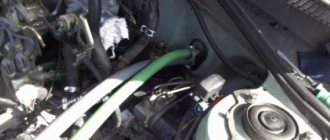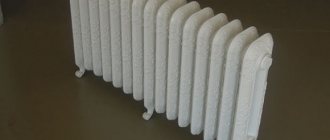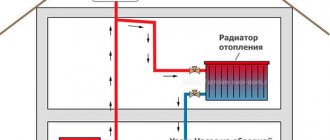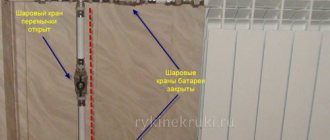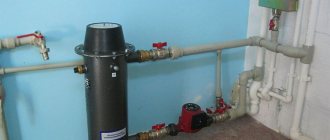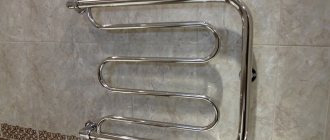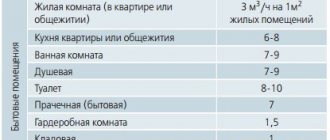Every heating system contains small particles that constantly circulate along with the liquid through the pipes. Most often, such substances are rust, scale or similar elements. When a lot of these components accumulate, problems begin with heating. Debris gets stuck in one place and begins to form deposits, which interfere with normal water circulation, and, consequently, heat exchange becomes worse. Of course, there is a solution to this problem - flushing the heating system.
The editors of the YaNashla website have prepared for you a rating of the best heating system cleaning products for 2021.
Is flushing the system necessary?
It is important to understand that not all apartments and private houses need washing. Since modern manufacturers are creating more innovative devices that do not accumulate sediment. And when heat exchange deteriorates, this does not always indicate pollution. Airing is common; this occurs after filling the system with new fluid. To eliminate this, first remove all the air, then add antifreeze or water. At first (about 2-3 weeks), the coolant will release sediment - this is a normal process, the main thing is to constantly clean the filters where it will fall out. After some time, when the impurities are exhausted, the precipitation of particles will stop.
When a person uses such a system (closed type), it will work for many years without any cleaning. The opposite situation is when heating needs constant replenishment from the outside. Then a person cannot avoid the formation of sediment. After 3-4 years, a large amount of debris will accumulate in the pipes, and sludge will form in the batteries. In this case, flushing is required.
A similar effect can occur due to the penetration of air into a closed system. The bubbles will begin to cause corrosion of the metal elements, which will cause the formation of iron oxide, which will accumulate in the filter all the time. The problem here will not be bad water, but plastic pipes that were manufactured without a protective oxygen barrier.
To ensure that the pipes begin to heat up again and do not leave the owner in the cold, the system should be flushed. But besides this, the cleaning process must be carried out:
- When heating appliances stop giving off heat. This can happen with one element or with several. The first sign is uneven heating of the sections when the bottom is completely cold. It should be understood that standard situations were considered and eliminated, but this did not affect heat transfer.
- When the heating system is constantly filled with fresh water or another substance. This often occurs when a person uses an electrode boiler, since in order for it to function normally, it is necessary to add water with a specific salt value. So the owner constantly monitors the chemical reaction and controls the level of salts or adds new coolant to automate the process.
- When a large amount of oxygen penetrates into the water. Signs of this problem are daily clogging of the sump tank and poor heat transfer, while the boiler operates at its maximum capacity.
If such problems occur, then the only solution is to flush the heating system. In this case, you can forget about frequency, since everything needs to be cleared so that the situation does not get worse. When the user is connected to central heating, then everything is much simpler, since the radiator network is flushed annually, after this stage pressure testing is carried out. It is carried out according to special standards.
Radiator flushing techniques
When selecting an acceptable method, the following are taken into account: the type of battery, the conditions and life of its operation, and its own capabilities.
Hydrodynamic technology
This flushing method is recommended to be practiced primarily when servicing cast iron radiators. The alloy has a porous structure, and other methods are ineffective. Their implementation allows only partial elimination of pollution, but there is no talk of complete cleanup (that is, restoration of Dy).
For flushing, a nozzle is used, inserted into the radiator one by one through all the pipes after removing the plugs. Hot water supplied under high pressure washes away any deposits from the treated area. Despite the high cost of this method of cleaning the battery, it is the most effective.
Pneumohydraulic flushing
Cleaning using this method is advisable if the radiator is slightly clogged. It's easy to do it yourself. Depending on the size of the battery, washing is organized in the area near the house or in the bathroom; First, you need to drain all the dirt from the heating device. Remaining deposits and rust are washed out with a stream of water from a hose (garden or shower head). As soon as clean liquid comes out of the radiator, the work can be considered completed. The optimal solution if any batteries are installed in the house, except cast iron products. The cavities of steel, aluminum, and bimetallic devices are smooth, and there will be no problems with cleaning them using this technology.
To speed up the process of flushing radiators, it is advisable to use auxiliary devices that increase pressure (pump, water pneumatic gun).
Chemical Technology
It is advisable to resort to this method when removing blockages in relatively old radiators, that is, those that have been in use for a long time. Even on initially smooth walls, scratches gradually appear from the smallest fractions transported through the system. As a result, deposits accumulate in these areas, which cannot be completely washed out even with powerful water pressure. Chemicals introduced into it or the use of aggressive liquids can soften the layer of dirt on the inner walls of the radiator. After this, as a result of repeated washing, it is easily removed.
Rating of the best concentrates for the heating system
TermoTactic CleanMaster
A good concentrate, which is intended for use in heating, ventilation and air conditioning systems. Thoroughly remove scale, traces of corrosion and carry out disinfection. The composition is completely safe for metal products and will not damage them during the cleaning process.
Sold at a price of 1,600 rubles per 10 kg.
TermoTactic CleanMaster
Advantages:
- High cleaning properties;
- Resistance even in hard water;
- Biodegradability rate;
- Disinfection;
- Removes the fat layer.
Flaws:
- Not found.
Dixis LUX / 10l
A budget option that is suitable for every heating system. In a short time it will remove the formed scale, silt and other harmful elements. Thanks to the high-quality composition, the formation of suspension and sedimentation are eliminated, which improves performance properties.
The average price is 1,440 rubles.
Dixis LUX / 10l
Advantages:
- Efficiency;
- High-quality cleaning;
- Easy to use;
- Restorative effect.
Flaws:
- Not found.
SteelTEX IRON
An excellent concentrate that is suitable for household and professional use. After its use, the heating system will begin to work more efficiently and guarantees the user high-quality cleaning. Scale and rust dissolve in strong acids, but this does not affect the internal appearance of metal elements.
The average price is 2,270 rubles.
SteelTEX IRON
Advantages:
- High-quality cleaning;
- Speed of work;
- Does not interact with main parts;
- Suitable for professional use.
Flaws:
- Price.
Prevention of slag build-ups inside heating systems
Often homeowners pay attention to the loss of thermal conductivity of the system only when the pipes are already thoroughly clogged. This is the main mistake. The fact is that it is better to carry out preventive flushing once a year using the same vinegar or whey than to clean the pipes several years later using “heavy artillery” and large financial costs. In fact, with preventative cleaning, the owner will lose no more than an hour of his free time, and if the blockage is severe, cleaning may take more than a day or two. There is something to think about.
Below we would like to present to your attention a photo of the most dense plugs in pipes and radiators of heating systems, which will not be so easy to get rid of.
Again, purchasing aggressive chemical compounds and hiring specialists can cost quite a large sum. Buying soda or vinegar is in no way comparable to similar expenses.
TOP powdered substances
BWT Cilit Neutra P
A powder substance that is used to neutralize an acid solution after flushing the heating with a chemical liquid. Before use, you must dilute the product in water; during this process, you must follow the instructions.
The average price is 3,700 rubles.
BWT Cilit Neutra P
Advantages:
- Cost-effective, since a small volume of powder can neutralize tens of liters of acid;
- Sold in durable packaging, which makes the product easy to store and transport;
- Effective acid neutralization.
Flaws:
- Not found.
SteelTEX ZINC
Concentrated powder that can effectively clean heating elements from traces of various contaminants. Used for both home and professional purposes. Compatible with all main materials used in the production of radiators.
The average price is 5,300 rubles.
SteelTEX ZINC
Advantages:
- Contains strong acids;
- Durable and convenient packaging;
- Does not cause corrosion;
- Easy to use.
Flaws:
- High price.
Rating of solutions that are immediately ready for use
Perkhim Medesk
Sold in a canister (20 liters) and is suitable for organizing effective flushing of the heating system. It is used by many professionals as the main remedy, since it contains excellent components that can remove scale and dirt in a short period.
The average price is 4,330 rubles.
Perkhim Medesk
Advantages:
- Good cleaning;
- Easy to use, as there is no need to dilute anything;
- Does not affect metal elements.
Flaws:
- Not found.
Syntilor Watesup 11 kg
One of the best ready-made products designed for quick cleaning. The product can be used in homes where plastic or metal pipes are used. Limestone and corrosion are removed quickly and efficiently. The product cleans the heating efficiently and does not damage the sealing parts.
The average price is 2,400 rubles.
Syntilor Watesup 11 kg
Advantages:
- Efficiency;
- Speed of action;
- Easy to use;
- Convenient packaging.
Flaws:
- Not found.
Cleaning methods
At the moment, there are several methods by which you can clean cast iron batteries from contaminants. Some craftsmen do all the work at home, while others prefer to turn to heating network workers for help.
We recommend: Uninterruptible power supply (UPB) for a solid fuel boiler
Each washing option has its own characteristics.
Dry cleaning
Dry cleaning involves everyday cleaning. Cleaning the outside of the battery is not difficult if you do it once a day or at least once a week.
Cleaning heating radiators from the outside:
- The vacuum cleaner comes with special attachments that can remove all the dust between sections if they are very close to each other.
- If you don't have a vacuum cleaner, you can use a hairdryer. We attach a damp cloth between the heating radiator and the wall. We direct the flow of hot air inside the sections and blow out all the accumulated dust. Thanks to the damp cloth, the dirt will not fall onto the carpet, but will stick to the rag. Then we rinse the cloth in clean water and continue cleaning other devices.
You can buy a special brush for heating radiators in the store. It will be easier for her to wipe off dirt. It is equipped with soft sponges that are very dense and allow you to clean the battery from several sides at once.
Wet cleaning
Use any detergent that can be used to clean the outside of a cast iron radiator.
Mix some liquid in a bucket of hot water, whip up foam. Dip the sponge and squeeze out excess water. Wipe the outside of the radiator, and don't forget about the piping and valves.
The wall behind the heating device can also be washed with soapy water.
Mechanical
For such cleaning, the pipes are disassembled. It effectively removes accumulated dirt, but is weakly effective against scale on the internal surfaces of the circuit. Before such flushing, close the valves before and after the boiler, then drain the water from the circuit using a drain valve. If it is not there, unscrew the cap on the radiator, which is located lower and farthest in the apartment. For greater efficiency, after draining the water, the batteries are dismantled.
To disassemble the radiator, use wrenches of the required size, including pipe wrenches. To do this, loosen the union nuts that connect the radiator to the pipes. The radiator is taken outside or into the bathtub, first covering it with thick textiles that protect it from mechanical damage. After washing, the textiles are discarded. The drain in the bathtub is covered with a mesh to prevent clogging of the sewer.
They clean the radiator with a cable and use it to clean the pipes. You can remove the primary dirt into a previously prepared container to reduce the load on the sewage system. For greater efficiency, before flushing, you can disassemble the radiator into sections of 2-3. After cleaning, the battery is washed by directing a stream of water into the internal circuit. To do this, use a hose with an adapter, ensuring the tightness of the hose connection. Stop washing when the outlet water becomes clear.
Dispersed
Biological flushing is an improved modification of the chemical method for removing clogged radiators. However, the action of the reagent here is somewhat different from the original method. The diluted reagent entering the system does not destroy the structure of metal radiators: its action is aimed at molecular rupture of the compounds of metal and compressed dirt. This method is applicable to batteries made of different materials, which is convenient and does not cause leakage.
The solutions used are not harmful to humans, so there are no problems with the disposal of waste material. During the washing process, dirt comes out of the batteries in a split form, so its pieces do not clog the radiator and pipe passages. After treatment, a special hydrophobic film is formed on the surface, which prevents the formation of new limescale deposits inside the circuit.
The process is carried out as follows:
- calculate the amount of reagent based on the characteristics of heating systems;
- prepare the device as in the chemical method;
- the device is connected to the system, the pump is turned on, liquid is introduced into the system circuit;
- after the required time, the waste material is drained into the sewer;
- flush the system with water several times;
- the system is filled with clean water.
When performing flushing during the heating season, you need to connect a device that closes the heating system.
Hydrodynamic
This technique involves supplying thin jets of water under high pressure to the heating system. Special nozzles are used for it. Water will not be supplied from a tap using a hose, but through a pump under pressure. Using this method, it is possible to stop the supply hose in particularly problematic areas where flushing is required. The method is considered environmentally friendly and effective for cast iron radiators.
However, it is not so easy to do it at home, because equipment that can provide water pressure of several hundred atmospheres is not cheap. In addition, such washing requires experience, which may require calling a specialist. Another disadvantage is the fact that the deposits must first be softened with a special solution, which is different for each battery material.
Hydropneumatic
This method involves flushing the heating system by supplying high pressure air inside the circuit. It is carried out through the inlet or outlet of one of the radiators, using a compressor, which is connected through a check valve. This connection prevents water from entering the system. The compressor supplies steam, creating a turbulent flow with high energy. This causes the build-up of compressed rust inside the circuit to be torn off and washed out of the system.
To flush radiators in this way, turn off the water. After this, a compressor with a pneumatic gun is connected to the radiator. When the batteries are not dismantled, the cap on the farthest one is unscrewed and a hose is connected through an adapter, which will collect debris. He is taken to the toilet. The first air supply, which is a short-term pulse, is carried out in the direction opposite to the circulation flow of the system.
Re-injection is performed by changing the direction of the air. To do this, the supply and collection hoses are swapped. To make the method more effective, you can dismantle the radiator, although this is more troublesome. The batteries can be taken outside, where it will be easier to wash them. After washing, they are put in place, then the circuit is connected to the coolant and the system is started to wash out any remaining dirt.
Then turn off the water supply, remove the drain hose, and put the plug in place. Now the system can be put into operation. The method is based on shock waves, of which a total of 2 to 5 may be needed. This flushing method does not take more than a few minutes if the radiators are not removed. It does not depend on electricity, since the installation operates autonomously. Its disadvantage is the limited range of action, which depends on the technical characteristics of the air gun used.
Electrohydropulse
This cleaning is carried out using electric discharge energy, which destroys scale and salts deposited inside the circuit. However, the batteries and pipes are not damaged. This method requires special equipment, although its efficiency is high, and the process itself does not require disassembling the heating system. The shock wave will destroy existing scale. And after the process, all that remains is to rinse the system with clean water to get rid of deposits that have lagged behind the walls.
This method is an alternative to replacing batteries. It is based on the application of an electrical charge in water and does not require a large amount of energy. After using a special installation, the heat exchange surfaces are completely cleaned of silt and lime deposits, which increases the internal cross-section of the circuit to the factory size. In this case, you can clean radiators and pipes of any configuration. A coaxial cable with special equipment at the end is placed into the pipe. During operation, periodic electrical discharges are created, which creates powerful waves and hydrodynamic flows, due to which effective cleansing occurs.
We recommend: Flushing the heat exchanger of a gas boiler: nuances of the procedure and review of cleaning products
Chemical
If you wish, you can clear communications yourself. But this is quite labor-intensive work, the complexity of which is determined, first of all, by the weight of the heating equipment.
During work using the chemical cleaning method, there is no need to violate the integrity of the system - disassemble the batteries into sections. It is most suitable when communications are installed in an autonomous heating system, that is, a private house, cottage or apartment.
The cleaning of cast iron heating radiators itself is carried out using chemical elements - reagents that are sold in many stores. If desired, improvised means can be used, for example, soda ash or caustic soda.
Cast iron radiators can also be washed with composite solutions, alkalis, organic and mineral acids in small proportions. Each container of chemicals has clear instructions to follow during cleaning. The fact is that these elements, with which batteries are cleaned, are aggressive substances. They affect not only scale and deposits, but also the material from which the radiator is made.
To extend the service life of the equipment, it is enough to clean it once every 3-4 years.
Often, when washing on their own, users make a serious mistake - they prepare an acid solution that is too concentrated. A large concentration of the washing solution will easily “eat up” the contaminants, and with them the sealing elements of the device. This may cause the batteries to leak. Chemical liquids should under no circumstances be used to clean aluminum radiators, unless it is a specially designed preparation.
If you lack skills, it is not recommended to carry out the work yourself, otherwise there is a possibility of permanently damaging the equipment. It is best to turn to specialists who have everything you need.
If you still want to do the cleaning yourself, it is not recommended to use too strong substances.
The best options are the salt of ethylenediaminetetraacetic acid or a more gentle option in the form of citric acid.
Hydrogen peroxide
A good helper in the household is 3% hydrogen peroxide. This well-known substance perfectly cleans and disinfects batteries. To use, add ¾ of a bottle to 2-3 liters of water. To remove severe stains, you can use pure peroxide by applying the substance directly to the stained area or with a sponge.
Lemon acid
Using citric acid, you can not only effectively clean the radiator from contamination, but also get rid of the unpleasant odor. As a rule, the smell appears from stagnant water and flower fertilizer that has reached the surface of the radiator. To prepare a cleaning solution, you will need to dissolve 3 tsp in a glass of water. citric acid.
Baking soda
Regular baking soda is suitable for cleaning the battery. To do this, dissolve 2 tbsp in 3 liters of water. l. soda For greater effect, you can add 1 tsp. apple cider vinegar and 7 drops of any liquid soap.
Vinegar 9%
Vinegar is poured into a spray bottle for further spraying onto the stained area, previously cleaned with a damp cloth. Afterwards, the battery must be thoroughly rinsed with water and wiped. Vinegar essence mixed with water in a ratio of 1:10 can also be used. When spraying in the room, the windows should be open; it is better to protect the respiratory tract with a mask.
Use of special compounds
Effortlessly, in just a few minutes, special cleaning products will help remove dirt and grease stains. To remove greasy stains, you can use dishwashing detergents, for example, Fairy, Pemolux, MYTH. Before use, it is necessary to dilute the concentrate in water, foam it and wipe the surfaces of the radiator with a brush or sponge. Light stains can be removed with laundry soap. Complex contaminants can be removed using special household chemicals intended for plumbing fixtures and household appliances, for example, Domestos, Krot, Tiret. Old stains are removed using stain removers, for example, “Vanish” and “Antipyatin”.
Using special equipment
At the moment, there are several types of special equipment used for cleaning batteries.
For domestic purposes this is the following equipment:
- pneumatic pistol "Typhoon";
- device for electrohydropulse influence ZEVS-24;
- Krot-Mini device.
Typhoon
The air gun is a compact and easy-to-use device. Thanks to its targeted effect on blockages, it can clean water and sewer pipes with a diameter of no more than 150 mm.
The essence of cleaning is a hydraulic ram, which, moving at a speed of 1.5 km/h, removes hardened deposits from the walls of the equipment. The maximum distance of the shock wave reaches 60 meters. The use of a pneumatic gun is important if conventional hydraulic flushing does not produce results.
ZEUS-24
Despite its small size, this equipment is powerful enough to destroy hardened deposits firmly stuck to the inner walls of pipes. It can be used to clean products with a diameter of seven to 150 mm.
The working principle is as follows: the device creates an electrical discharge, resulting in a shock wave and powerful hydrodynamic flows. The ZEUS-24 installation allows you to clean hard-to-reach bent and spiral pipes.
Mole Mini
This installation cleans communications with a diameter of 20 to 150 mm - intra-house sewer networks and other pipelines. Thanks to the spiral installed in the drum, cleaning hard-to-reach places is easier.
The device is used in many sectors of human activity: from housing and communal services, hotels, gas stations to industrial enterprises.
Electrical appliances
Thorough cleaning of the battery can be done using electrical appliances. It is important to take precautions.
Vacuum cleaner
You can use a vacuum cleaner for cleaning. It is advisable to use a narrow nozzle, this will allow you to penetrate hard-to-reach places. First you need to remove all dust and debris from the inside, then treat the outside. When finished, you can wipe the radiator with a damp cloth.
Hairdryer
To use a hair dryer, you must first place a towel or any thick cloth soaked in water under the radiator. Direct a stream of hot air onto the radiator. The dust will move from the battery to the damp cloth. Not the most effective way: dirt can remain between the sections, get into the air or walls, floor.
Washing vacuum cleaner
A good alternative to a regular vacuum cleaner. It will cope perfectly even with serious dirt. Cleaning should begin from the inside, and then proceed to the outer surface. A washing vacuum cleaner, thanks to an aqua filter, can prevent the spread of dust throughout the room.

